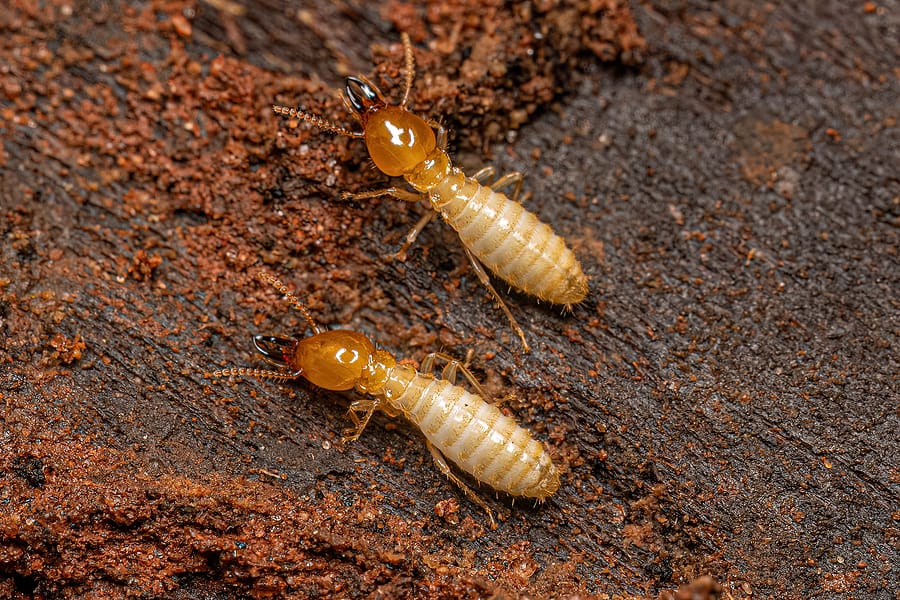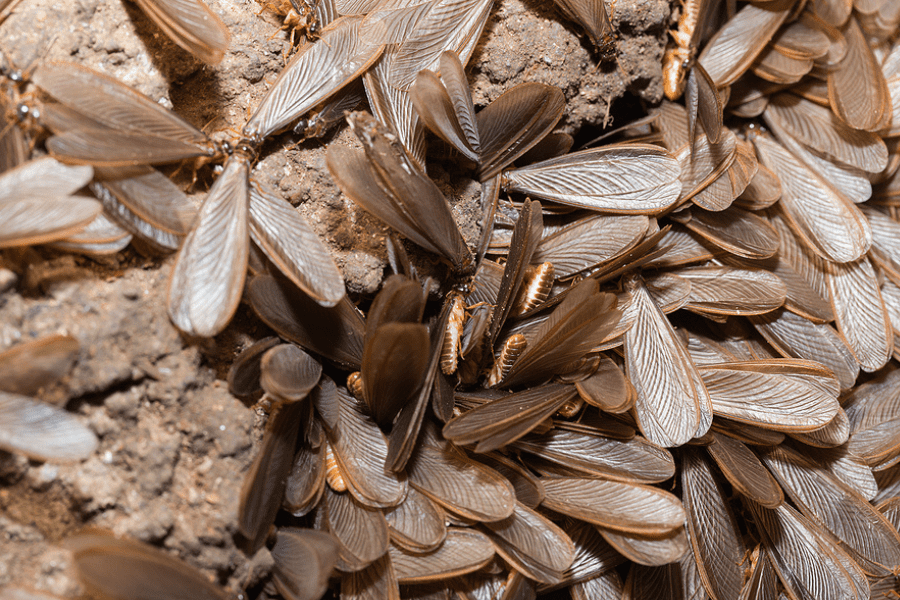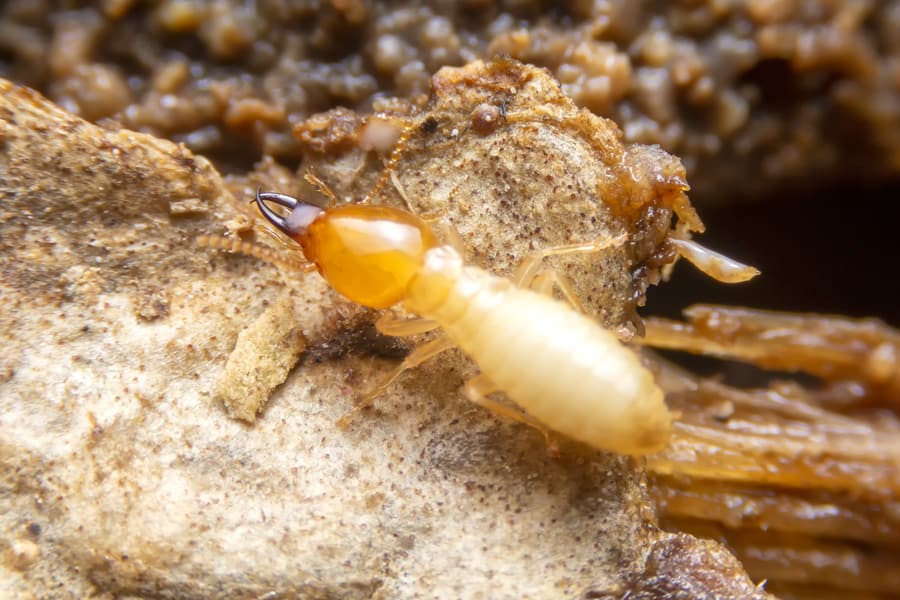READY TO GET STARTED?
REQUEST A FREE ESTIMATE
Fill out the form below or call (888) 466-7849 for a free, no-obligation estimate.

Termites are so destructive because they eat wood from the inside out, often going long periods of time before they are discovered. For this reason, annual termite inspections are critical to protecting your home. These inspections help spot signs of termites sooner, allowing termite control to be implemented earlier in the termite infestation.
There are several different options when it comes to termite treatments. Here are four of the most popular:
Liquid-soil termite treatments are applied to the soil around your home to act as a treatment barrier. They last for an average of 5 years. A trench is dug around the perimeter of your home, and liquid termiticide is applied. The trench is then filled in. This method helps to prevent future infestations while also killing any existing termites as they travel between your home and their nests.
Bait station treatments are another option for termite control. Bait stations are strategically placed around your home using this method. Each station contains a slow-acting termiticide that the termites take back to their nests and share with other termites. These treatments may take longer to work on termites. They also necessitate regular monitoring and maintenance to ensure that each station contains bait.
Wood treatments are an additional termite control option. These treatments make use of either surface sprays and treatments or injected sprays and foams. Wood treatments kill existing termites while also penetrating the wood to prevent future problems. These treatments necessitate direct access to infested wood, which can be difficult to obtain in some cases. Sprays are better for new construction treatments because the wood can be treated while the house is being built. Injected foams are better for use on existing structures because they can expand into cracks and crevices that sprays may not be able to reach.
Pre-treated building materials are ideal for new construction. The termiticide can be sprayed or brushed on. Termiticide can also be applied anywhere the new structure comes into contact with the soil, allowing the soil to be pretreated. Using pressure treated wood is another option because termites are less likely to infest wood that has been treated with chemicals.
While these termite treatment options are efficient at eliminating existing infestations, unfortunately they do not provide permanent elimination of termites. There is always a risk that termites will return to invade again. Termite control is an ongoing process, requiring persistent maintenance and prevention techniques to continue to keep them out.
You can prevent termites by:
Contact your local pest control company for a thorough evaluation.
How to Keep Spring Wildlife Out of Your Home
How Dangerous Is The Water Moccasin?

The new year has begun and although the weather is chilly now, the luxuries of living in the south typically means that warmer weather appears sooner than later. This means that termite swarming season is just around the corner, with the earliest swarms beginning in February. Let’s break down what to expect this swarming season.
Termite swarmers, often mistaken for winged ants, are most active during the spring months, when they fly away from their colony to reproduce. These swarmers are attracted to bright, light areas often seen around doors and windows in homes. Fortunately, they don’t cause wood damage, but seeing a group of them around your property typically means a colony is nearby.
The southeastern region of the United States is home to a variety of termites, including the subterranean, drywood, and Formosan species. Subterranean is the most common type of termite found in the southeast. They live underground in colonies that can get up to two million members. They are also known to be found in moist, secluded areas above ground. With their hard, saw-toothed jaws that work like shears, they are known to cause significant damage to properties.
If you suspect termite swarming activity or just want to get a step ahead at termite prevention, contact your local pest control company and schedule your free inspection.

Hot, humid weather is inevitable when you live in the Fort Lauderdale area. Unfortunately, pests like termites thrive in these conditions, looking to our homes for a food source. Termites will eat wood inside out, sometimes going undetected for a long period of time. Some common termite species include drywood termites and subterranean termites. To enhance termite control around your home, it’s important for every homeowner to utilize preventative measures throughout their property.
Improper drainage is one of the most common reasons termites infest. Subterranean termites are looking for moist wood to infest, causing significant structural damage. Our gutters often clog, causing water to pool and create insulation vulnerable to termites. Likewise, the leaves, twigs, and debris can get caught and build up in gutters, softening your roof and causing it to rot. Divert your down-spout away from your home and consider utilizing splash blocks to prevent pooling water.
Showing off your beautiful landscaping and a green, lush yard is ideal for every homeowner. Unfortunately, the materials we sometimes use to create this can be beneficial to termites. Landscaping mulch can be aesthetically pleasing, but unfortunately, it can attract termites into our homes. Try to minimize your use of mulch but if you do utilize it, keep it away from your foundation by at least 15 inches.
Excessive moisture can cause multiple problems for your home, including termites. Leaking pipes or lack of airflow can create an ideal environment for these pests. A major step in preventing termites is eliminating excessive moisture inside the home. Enclosing your crawlspace is a great way to not only prevent termites and other pests, but to also improve the overall health of your home.
If you’ve taken as many precautions as possible to avoid termites but are still looking for extra protection, consider reaching out to your local Fort Lauderdale pest control company. These professionals can provide you with a termite inspection and a treatment and prevention plan customized to your home.

It’s Termite Awareness Week, and termites are a known threat to southern homeowners. Termites can cause more than 5 million dollars in property damage throughout the United States, and it is normal for this damage not to be covered by homeowner’s insurance policies. Before the damage gets out of control, look for termite signs and consider getting a preventative termite treatment and warranty from professional help.
One of the first signs that termites are near is if you encounter swarmers near your home. Although swarmers do not cause wood damage, they do indicate that a colony is nearby. If you notice swarmers, it’s best to take immediate action and have a local termite control company take a look.
Another tell-tale sign that termites are close by is the presence of mud tubes or tunnels along the foundation of your home. Termites use mud tubes to keep moisture when traveling to and from their colony and your home.
Some other signs of termites that you may notice are:
Even if you do not find signs of termites, now is still the perfect time to get preventative termite protection! With the Sentricon Always Active bait system, you’ll experience 24/7 termite protection, annual inspections, a lifetime termite warranty, and more! Reach out to your local pest control company to help identify the type of termite and recommendations on the best treatment plan.

Did you know that certain termite species, such as subterranean termites, are active year-round? This means that even on the hottest or coldest days of the year these pests can still cause considerable damage and destruction to your property. Termites are in search of two things: a food source and a place to establish their colony. The first step in preventing termites is knowing what attracts them so you can take the necessary precautions to avoid them!
Termites like to colonize near a food source, most often soft or rotting wood. Firewood and other wood piles throughout your property are a major attractant to termites. This wood provides them with both a supply of food and a place to create their colony. If you must have this wood on your property, place it at least 20 feet from your home and elevate it at least 5 inches off the ground.
Summer showers are inevitable, meaning that your gutters could quickly become clogged. While clogged gutters can damage your home’s foundation, they can also attract termites. As the debris blocking the gutters accumulate, the excess moisture can soften your roof and cause it to rot. These areas provide termites an easy way to get inside your home. Make sure that your gutters are cleaned out regularly, especially after a bad rainstorm or consider installing gutter guards.
Every homeowner wants their yard to look aesthetically pleasing but sometimes the materials used for landscaping (like mulch) can attract termites to your home. Mulch is comprised of wood chips that can retain moisture, making it a perfect source of food for termites. Instead of mulch, consider using landscaping rocks; if you do use mulch, place it at least 15 inches from your foundation.
If you suspect a termite infestation or just want to get ahead of preventing them, consider calling your local pest control company where they can provide you with the best termite control options for your home.